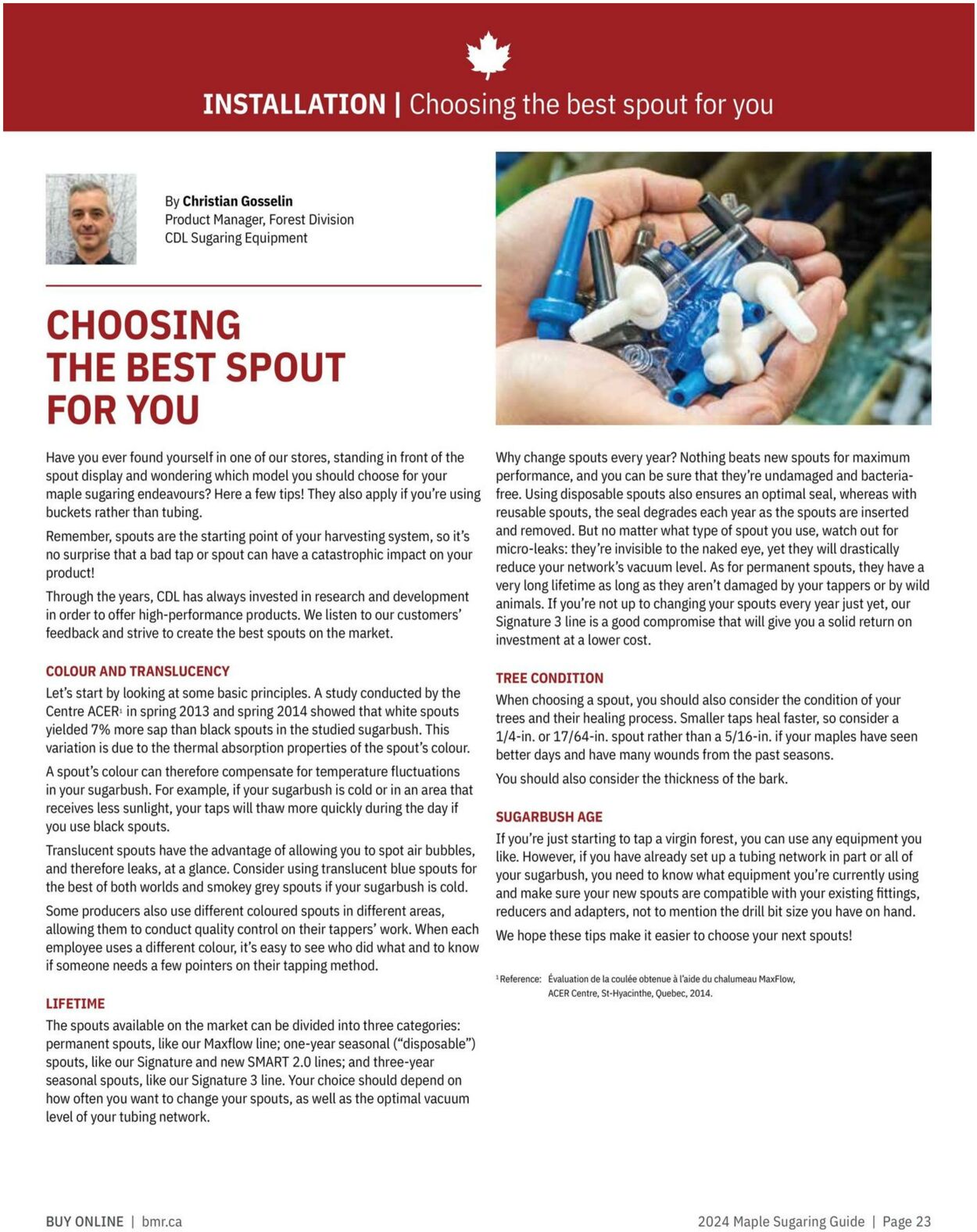

Products in this flyer
& INSTALLATION | Choosing the best spout for you By Christian Gosselin Product Manager, Forest Division CDL Sugaring Equipment CHOOSING THE BEST SPOUT FOR YOU Have you ever found yourself in one of our stores, standing in front of the spout display and wondering which model you should choose for your maple sugaring endeavours? Here a few tips! They also apply if you’re using buckets rather than tubing. Remember, spouts are the starting point of your harvesting system, so it’s no surprise that a bad tap or spout can have a catastrophic impact on your product! Through the years, CDL has always invested in research and development in order to offer high-performance products. We listen to our customers’ feedback and strive to create the best spouts on the market. COLOUR AND TRANSLUCENCY Let’s start by looking at some basic principles. A study conducted by the Centre ACER: in spring 2013 and spring 2014 showed that white spouts yielded 7% more sap than black spouts in the studied sugarbush. This variation is due to the thermal absorption properties of the spout’s colour. Aspout’s colour can therefore compensate for temperature fluctuations in your sugarbush. For example, if your sugarbush is cold or in an area that receives less sunlight, your taps will thaw more quickly during the day if you use black spouts. Translucent spouts have the advantage of allowing you to spot air bubbles, and therefore leaks, at a glance. Consider using translucent blue spouts for the best of both worlds and smokey grey spouts if your sugarbush is cold. Some producers also use different coloured spouts in different areas, allowing them to conduct quality control on their tappers’ work. When each employee uses a different colour, it’s easy to see who did what and to know if someone needs a few pointers on their tapping method. LIFETIME The spouts available on the market can be divided into three categories: permanent spouts, like our Maxflow line; one-year seasonal (“disposable”) spouts, like our Signature and new SMART 2.0 lines; and three-year seasonal spouts, like our Signature 3 line. Your choice should depend on how often you want to change your spouts, as well as the optimal vacuum level of your tubing network. BUY ONLINE | bmr.ca Why change spouts every year? Nothing beats new spouts for maximum performance, and you can be sure that they're undamaged and bacteria- free. Using disposable spouts also ensures an optimal seal, whereas with reusable spouts, the seal degrades each year as the spouts are inserted and removed. But no matter what type of spout you use, watch out for micro-leaks: they're invisible to the naked eye, yet they will drastically reduce your network’s vacuum level. As for permanent spouts, they have a very long lifetime as long as they aren’t damaged by your tappers or by wild animals. If you're not up to changing your spouts every year just yet, our Signature 3 line is a good compromise that will give you a solid return on investment at a lower cost. TREE CONDITION When choosing a spout, you should also consider the condition of your trees and their healing process. Smaller taps heal faster, so consider a 1/4-in. or 17/64-in. spout rather than a 5/16-in. if your maples have seen better days and have many wounds from the past seasons. You should also consider the thickness of the bark. SUGARBUSH AGE Tf you're just starting to tap a virgin forest, you can use any equipment you like. However, if you have already set up a tubing network in part or all of your sugarbush, you need to know what equipment you're currently using and make sure your new spouts are compatible with your existing fittings, reducers and adapters, not to mention the drill bit size you have on hand. We hope these tips make it easier to choose your next spouts! * Reference: Evaluation de la coulée obtenve a aide du chalumeau MaxFlow, ACER Centre, St-Hyacinthe, Quebec, 2014. 2024 Maple Sugaring Guide | Page 23
| Name | Details |
|---|